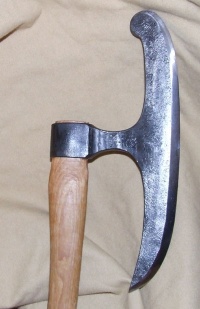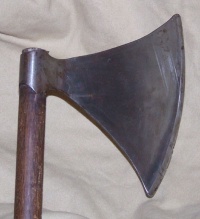Axe: Difference between revisions
No edit summary |
m (Reverted edits by 206.219.100.110 (Talk); changed back to last version by Planish) |
||
| Line 1: | Line 1: | ||
c4talr |
|||
==Axe ([[tool]])== |
==Axe ([[tool]])== |
||
[[image:bayeuxaxe.jpg|right|200px|thumb|Replica 11th century broadaxe.]] |
[[image:bayeuxaxe.jpg|right|200px|thumb|Replica 11th century broadaxe.]] |
||
Revision as of 09:39, 2 November 2007
Axe (tool)
A bladed tool, customarily used for hewing, chopping or shaping wood. Think hammer but with an edged blade in place of the flat/convex head. The back of the axe is referred to as the poll and in some axes is used as a striking surface for driving the axe further into wood using a mallet or maul. Possibly more common than hammers in the neolithic period, because flints and other breakable rocks more often break to leave edges (especially when you're using them as hammers).
Axe shapes in the medieval period depended on their use. Felling axes have very basic shapes often similar to some modern felling axes (not the American style), but others have a beard that is useful for protecting the hands when shaping boards. Early medieval axes seem to be categorised by eyes that have small lugs or none at all. Later medieval axes developed metal sheathes that extend down the handle a distance, but are not always present.
Felling axes are shaped so that the edge forms an axis of symmetry throught the centre of the axe. Broadaxes (such as the t-shaped examples show working on the ships in the Bayeux Tapestry) have this edge offset so that they can be used to shape boards and smooth planks.
You will often see or hear the term "double-headed" axe, when what they really mean is a "double-bitted" axe. It has only one head, but the opposite sides of that head both have a sharpened edge.
Axe (weapon)
The axe is a weapon often associated with the Vikings. Possibly a common weapon as most people would have access to one. Two-handed axes such as the daneaxe were used by elite troops in the early medieval period and proved to be popular with many nobles later in history.
Historically, hand axes like the francisca lost some popularity when armour got too solid for them to go through easily, but this was restored when they were put on poles (see pole axe), which gave range and increased hitting power.
Axes in the SCA
An axe may also be used as a weapon in SCA tournaments or melees. The handle of the axe is made of rattan. The head can be made of various things, such as rubber, foam, rattan or leather.
The smaller, lighter throwing axe is a missile weapon, so it is not used in tournaments. Rubber and more foam is used instead of rattan in its construction (NEED TO CHECK THIS).

